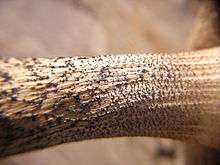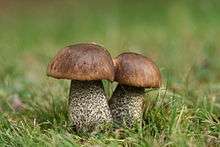Leccinum
| Leccinum | |
|---|---|
 | |
| L. aurantiacum | |
| Scientific classification | |
| Kingdom: | Fungi |
| Division: | Basidiomycota |
| Class: | Agaricomycetes |
| Order: | Boletales |
| Family: | Boletaceae |
| Genus: | Leccinum Gray |
| Type species | |
| Leccinum aurantiacum (Bull.) Gray (1821) | |
| Synonyms[1] | |
Leccinum is a genus of fungi in the family Boletaceae. It was the name given first to a series of fungi within the genus Boletus, then erected as a new genus last century. Their main distinguishing feature is the small, rigid projections (scabers) that give a rough texture to their stalks. The genus name was coined from the Italian Leccino, for a type of rough-stemmed bolete. The genus has a widespread distribution, especially in north temperate regions, and contains about 75 species.[2]
Ecology and habitat

Leccinum species are generally found in the woodlands of Europe, Asia, and North America, forming ectomycorrhizal associations with trees. Most Leccinum species are mycorrhizal specialists, associating with trees of a single genus. Leccinum aurantiacum is an exception, however, occurring in mycorrhizal association with birch, poplar, and oak.[3]
As food
They have generally been presumed to be edible for the most part, but there are reports of poisoning after eating as yet unidentified members of the genus in North America, even after thorough cooking. The orange- to red-capped species, including L. insigne, are suspected. Species of Leccinum often cause nausea when consumed raw.[4][5][6]
Species

There are around 75 species including:
- L. albellum
- L. atrostipitatum
- L. aurantiacum — Red-capped scaber stalk
- L. boreale — Northern roughstem
- L. crocipodium
- L. cyaneobasileucum
- L. discolor
- L. duriusculum — Slate bolete
- L. griseum
- L. holopus
- L. insigne — Aspen bolete
- L. intusrubens — (Malaysia)
- L. lepidum
- L. manzanitae — Manzanita bolete
- L. piceinum
- L. ponderosum
- L. pseudoscabrum
- L. quercinum
- L. rhodoporosum[7]
- L. roseofractum
- L. scabrum — Birch bolete
- L. variicolor
- L. versipelle — Orange birch bolete
- L. violaceotinctum
- L. vulpinum
References
- ↑ "Synonymy: Leccinum Gray". Species Fungorum. CAB International. Retrieved 2015-02-08.
- ↑ Kirk PM, Cannon PF, Minter DW, Stalpers JA (2008). Dictionary of the Fungi (10th ed.). Wallingford: CABI. p. 364. ISBN 978-0-85199-826-8.
- ↑ den Bakker, Henk C.; Zuccarello, G. C.; Kuyper, TH. W.; Noordeloos, M. E. (2004). "Evolution and host specificity in the ectomycorrhizal genus Leccinum" (PDF). New Phytologist. 163: 201–15. doi:10.1111/j.1469-8137.2004.01090.x.
- ↑ Beug, Michael W. (March–April 2004). "An Overview of Mushroom Poisonings in North America". The Mycophile. 45 (2): 4–5.
- ↑ Beug, Michael W.; Shaw, Marilyn; Cochran, Kenneth W. (Fall 2006). "Thirty-Plus Years of Mushroom Poisoning: Summary of the Approximately 2,000 Reports in the NAMA Case Registry" (PDF). McIlvainea. North American Mycological Society. 16 (2): 47–68.
- ↑ Beug, Michael W. "NAMA Toxicology Committee Report for 2007: Recent Mushroom Poisonings in North America". Retrieved 2011-04-04.
- ↑ Takahashi H. (2007). "Five new species of the Boletaceae from Japan". Mycoscience. 48 (2): 90–9. doi:10.1007/s10267-006-0332-6p.
External links
| Wikimedia Commons has media related to Leccinum. |
- Leccinum in Index Fungorum
- Leccinum in MycoBank.
- Noordeloos, Machiel. "The genus Leccinum in Western and Central Europe". Retrieved 2011-04-04. Includes key.
- Kuo, M. (May 2007). "The genus Leccinum". MushroomExpert.com. Retrieved 2011-04-04. Includes key to North American species.
- Scates, Kit; Gibson, Ian; Bishop, Richard (2004). "Trial field key to the BOLETES in the Pacific Northwest". Pacific Northwest Key Council. Retrieved 2011-04-04. Includes Leccinum species.